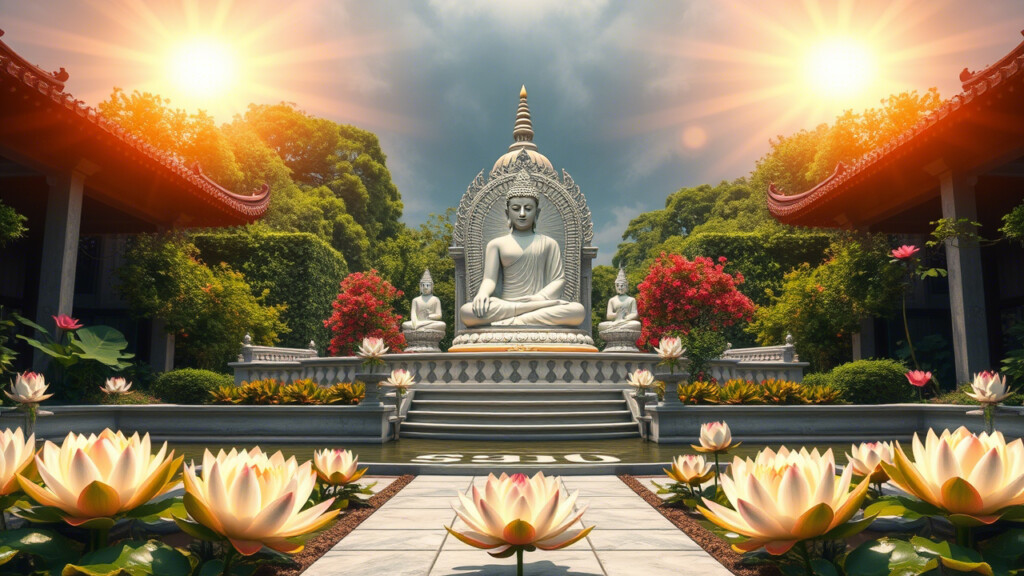When people hear about Nirvana, they often imagine it as a distant place or even mistake it for death. However, Nirvana is not a destination, nor is it an end—it is a state of absolute liberation where one is no longer bound by craving, suffering, or ignorance.

So, what exactly is Nirvana? Is it a faraway realm, or is it something that can be attained in everyday life? Let’s explore!
Nirvana: Not Death, But Awakening
We often associate everything with images and locations, so when we think of Nirvana, many assume it must be a place—like heaven in other religions. But in Buddhism, Nirvana is not a location but a pure state of consciousness where one is free from all afflictions, desires, and attachments to the self.
However, it is crucial to clarify a key distinction:
- In Theravāda Buddhism, Nirvana is the complete cessation of rebirth—a final liberation from existence itself. This is known as “Parinirvana,” which occurs when an enlightened being passes away and is no longer subject to the cycle of birth and death.
- In Mahayana Buddhism, Nirvana is not the end of existence but the realization of ultimate wisdom and compassion. A being who attains Nirvana may continue to exist, but they are no longer bound by samsara (the cycle of birth and death).
Understanding what is Nirvana in Buddhism requires recognizing that it is not mere escapism or annihilation. If death is the end of the physical body, then Nirvana is the release from the invisible chains of the mind. Those who attain Nirvana are no longer disturbed by desires, anxieties, or suffering. They are free from the constraints of time, past regrets, and future worries, living in a state of absolute peace.
In other words, Nirvana is not the cessation of existence—it is the beginning of an unbound existence.
Science: Nirvana and the Human Brain
Although Nirvana is a spiritual concept, modern science has begun to shed light on the state of deep tranquility and liberation that Buddhism describes.
📌 Research on meditation and its impact on the brain:
Neuroscientific studies have found that deep meditation reduces activity in the amygdala (the brain region linked to stress and anxiety) while strengthening the prefrontal cortex, which is associated with clarity, focus, and emotional regulation.
A study by Dr. Richard J. Davidson at the University of Wisconsin-Madison found that Tibetan monks who had meditated for tens of thousands of hours exhibited extremely high levels of gamma wave activity—brain waves linked to heightened awareness and deep happiness.
This suggests that the state described in Buddhism—a mind unshackled by suffering—can be achieved through mental training and practice. The scientific benefits of meditation demonstrate that cultivating mindfulness and detachment can lead to profound psychological and physiological well-being.
In short: Nirvana may not be a mystical phenomenon, but a psychological state that can be activated through meditation, mindfulness, and letting go.
Psychology: Nirvana and Inner Freedom
From a psychological perspective, Nirvana can be seen as a state of absolute inner freedom—where one is no longer enslaved by negative emotions or aimless thoughts.
The renowned psychologist Carl Rogers emphasized that happiness does not come from controlling everything, but from letting go of unrealistic expectations and pressures we place on ourselves.
Modern therapeutic approaches like Mindfulness-Based Stress Reduction (MBSR) and Cognitive Behavioral Therapy (CBT) also focus on helping individuals observe their thoughts, detach from suffering, and cultivate inner peace. The psychology behind Nirvana suggests that inner liberation comes not from acquiring more, but from releasing attachments to what we cannot control.
✨ When you stop clinging to fears, worries about the future, or regrets from the past, you touch a true sense of tranquility.
And that is the essence of Nirvana.
Nirvana vs. Enlightenment: What’s the Difference?
Many people confuse Nirvana vs. enlightenment meaning, but they are not exactly the same. While Nirvana is the complete cessation of suffering and desire, enlightenment (or “Bodhi”) refers to the profound realization of truth that leads to Nirvana.
- Enlightenment is the moment of awakening—when one sees reality clearly, without illusion.
- Nirvana is the ultimate state of peace and liberation that follows enlightenment.
In essence, enlightenment is the path, while Nirvana is the destination. However, since Nirvana is not a “place” but a state of mind, it can be experienced even in daily life when one attains deep inner freedom.
Have You Reached Nirvana?
Nirvana is not something far away—it emerges the moment you let go of what binds you.
Imagine you have two young children. One is crying for food, while the other stubbornly refuses to eat. They run around the house, turning the living room into a battlefield, while all you want is a moment of peace. You’ve tried everything—soothing them, scolding them, even promising new toys—but they couldn’t care less about your logic.
Then one day, you stop. You take a deep breath and accept a simple truth: children are just like this. You stop trying to control them, stop getting frustrated over the mess, stop stressing about an unfinished meal. Instead, you smile, sit on the floor, and embrace the beautiful chaos of the moment.
Instantly, you feel lighter. You realize that what exhausted you was not the children themselves, but your expectation that they would behave differently.
🚀 Nirvana is the moment you stop fighting reality and start embracing it as it is.
Final Thoughts
Nirvana is not a place to reach, nor is it a mystical concept beyond our grasp. It is already within you.
💡 The moment you let go, the moment you live fully in the present, you will realize that liberation has never been far away.
🔥 So, have you touched your Nirvana yet?
